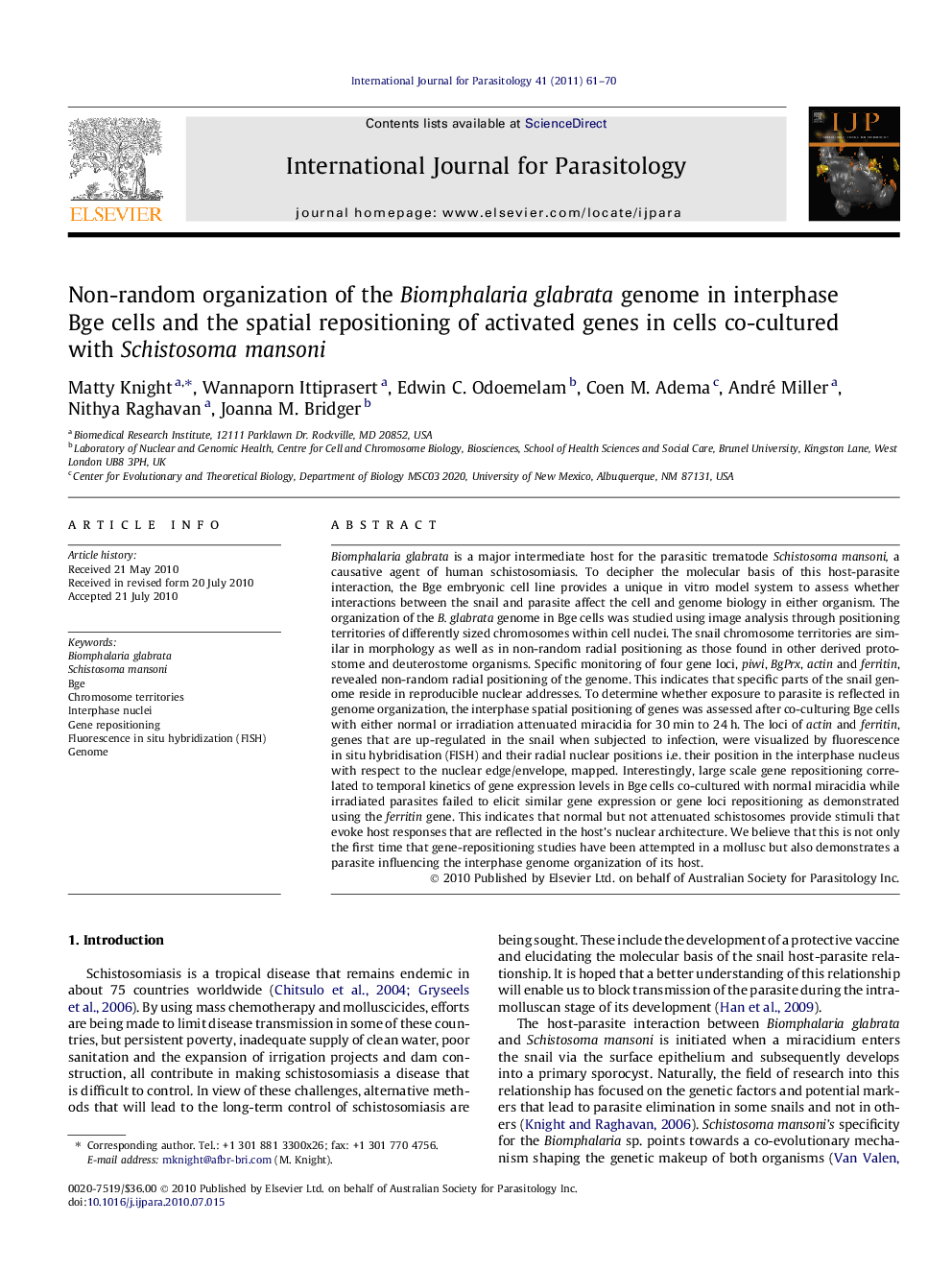| کد مقاله | کد نشریه | سال انتشار | مقاله انگلیسی | نسخه تمام متن |
|---|---|---|---|---|
| 2436279 | 1107297 | 2011 | 10 صفحه PDF | دانلود رایگان |

Biomphalaria glabrata is a major intermediate host for the parasitic trematode Schistosoma mansoni, a causative agent of human schistosomiasis. To decipher the molecular basis of this host-parasite interaction, the Bge embryonic cell line provides a unique in vitro model system to assess whether interactions between the snail and parasite affect the cell and genome biology in either organism. The organization of the B. glabrata genome in Bge cells was studied using image analysis through positioning territories of differently sized chromosomes within cell nuclei. The snail chromosome territories are similar in morphology as well as in non-random radial positioning as those found in other derived protostome and deuterostome organisms. Specific monitoring of four gene loci, piwi, BgPrx, actin and ferritin, revealed non-random radial positioning of the genome. This indicates that specific parts of the snail genome reside in reproducible nuclear addresses. To determine whether exposure to parasite is reflected in genome organization, the interphase spatial positioning of genes was assessed after co-culturing Bge cells with either normal or irradiation attenuated miracidia for 30 min to 24 h. The loci of actin and ferritin, genes that are up-regulated in the snail when subjected to infection, were visualized by fluorescence in situ hybridisation (FISH) and their radial nuclear positions i.e. their position in the interphase nucleus with respect to the nuclear edge/envelope, mapped. Interestingly, large scale gene repositioning correlated to temporal kinetics of gene expression levels in Bge cells co-cultured with normal miracidia while irradiated parasites failed to elicit similar gene expression or gene loci repositioning as demonstrated using the ferritin gene. This indicates that normal but not attenuated schistosomes provide stimuli that evoke host responses that are reflected in the host’s nuclear architecture. We believe that this is not only the first time that gene-repositioning studies have been attempted in a mollusc but also demonstrates a parasite influencing the interphase genome organization of its host.
Graphcial abstractFigure optionsDownload high-quality image (64 K)Download as PowerPoint slideResearch highlights
► Using the snail Bge cell-line, we show for Biomphalaria glabrata that interphase chromosomes are non-randomly organized as individual territories in a radial distribution, demonstrated by Flourescense In Situ Hybridiztion (FISH) for four specific gene loci, actin, ferritin, piwi and peroxiredoxin.
► Specific temporal repositioning or relocation of gene loci within interphase nuclei after in vitro schistosome co-culture with Bge cells was determined.
► Significant gene loci repositioning within nuclei tightly correlated with gene expression, with one gene (ferritin) moving to the nuclear interior and one gene (actin) moving to the nuclear periphery concurrently with up-regulated gene expression.
► The dynamics for ferritin gene loci re-positioning were not elicited when radiation attenuated parasites were similarly co-cultured with Bge cells.
Journal: International Journal for Parasitology - Volume 41, Issue 1, January 2011, Pages 61–70